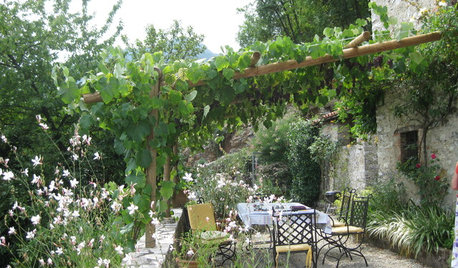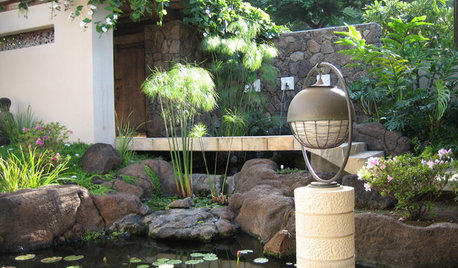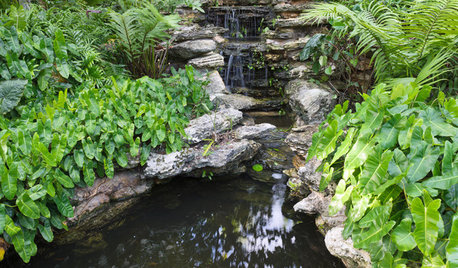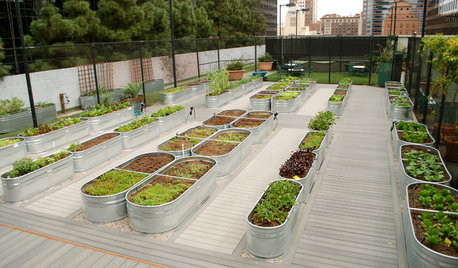my soil recipe for planting roses
tell me what you think of this combo:
i start with some #4 soil mix. then i add miracle grow potting soil along with black gold worm castings. a little bit of blood meal in there as well. mix it all up . then i put some blood meal around the root ball of a lucky rose, and line the bottom of hole with bone meal. then i plant the rose, throw a thin layer of osmocote and water well. no joke, i have seen roses start flourishing virtually over night with this combination. i personally believe it is more important to prepare the soil properly, than to fertilize the heck out of the rose later.i dont liquid fertilize for about 6 weeks and when i do, it is at half strength.
Comments (36)
Embothrium
16 years agoI wouldn't do most of it, if any. For page with pertinent discussions (scroll through titles that appear to relate and click to open)...
Here is a link that might be useful: Horticultural Myths
Related Professionals
Redondo Beach Landscape Architects & Landscape Designers · South Elgin Landscape Architects & Landscape Designers · Waterbury Landscape Contractors · Battle Ground Landscape Contractors · Indianapolis Landscape Contractors · Mission Landscape Contractors · Pikesville Landscape Contractors · Winchester Landscape Contractors · Oxon Hill Landscape Contractors · Lake Forest Swimming Pool Builders · West Hollywood Swimming Pool Builders · Willoughby Swimming Pool Builders · Perth Amboy Siding & Exteriors · San Antonio Siding & Exteriors · Thornton Siding & Exteriorsbuford
16 years agowhy potting soil and not garden soil? Or did you use the wrong term?
It probably depends on if you have good soil or have amended. I have mostly clay so have to use purchased garden soil (usually MG) and I sometimes as bonemeal when planting.
pete41
16 years agoFirst of all it will take several weeks for the rose to develop sufficient feeder roots in the soil surrounding the root ball to have much effect.In the meantime its the nutrients in the root ball that your new planting is flourishing on.Secondly most of the stuff people use to amend the soil is below the level of the feeder roots,hence useless.
The misconception comes from roses that become root bound in pots they are put in as bare roots.Having no where else to go they go down wards.Not in the ground.Anchor roots will.
NPK and minors are well known needs to compliment the photosynthesis process.No magic ingredients.lolEmbothrium
16 years agoBare-rooting at planting of potted stock now being advocated (see discussion, at site linked to above). Following that approach they're all "bare-roots." You want the same soil texture through the whole rooting area, so there isn't a watering problem later. Amended backfill and intact potting soil rootballs have a different texture from the unamended soil around them.
joebar
Original Author16 years agowow- wasn't expecting all of the K.I.S.S. scolding. i wouldn't be doing it if it didn't work.everyone of my 25 roses are show quality or very close to it. it seems logical to me that why use the soil that is there if you can improve it without much effort? i forgot to mention that two thirds of them are in containers.
paparoseman
16 years agoI would keep about half of the natural soil that came from the hole. Everything else is open for my roses. Personally I use Whitney Farms Mushroom compost, along with bone meal, alfalfa meal, super phosphate and blood meal.
My yard is full of sandy soil and some of my roses actualy have clumping cat litter added to help the soil hold water. I use non perfumed litter and mix it throughly in the hole to avoid clumped clay roots.
Lance
Embothrium
16 years agoWithout running a trial with half the roses not planted in amended backfill you don't know if it helped or not (it doesn't, this has been demonstrated many times). Nutrient applications (fertilization) should be based on sampling and testing of soil, soils vary in nutrient availability both from one spot to the next and seasonally. Same lot can have different soils from one area to the next, fertilizer that works on one soil will not be appropriate for another. What is useful to Bob in Ohio may have absolutely no bearing on what Jane in Delaware needs to do to get good results.
jeff_zephyr
16 years agoJoe: I would like to try your method. How do you apply the blood meal around the root ball? Also, can you explain what a #4 soil mix is?
Thanks!
Jeff
berndoodle
16 years agoI'm guessing soils scientists aren't in universal agreement about planting in unamended soil. I have seen many more trees and shrubs fail within the first 6 months of planting in unamended soil than roses planted in amended soil. Many homeowners garden in heavily compacted subsoils from which the topsoil has been removed. Planting in unamended subsoil, especially in a low rainfall area, is a recipe for failure.
Even in undisturbed soil, the soil scientist I consulted prescribed a custom mix to use for amendment and backfilling. Interesting, the components are generally what rosarians would add: time-release nitrogen, organic matter, a source of phosphate and something to balance the pH. Native soil is mixed with the amendment, and the filled hole must be watered and cured for several weeks before planting outside the rainy season.
I do believe those amendments will degrade and leach within a number of years. By then, the plant will be mature and will have established itself. The benefits of mulch will have worked magic on the top 6 or 8 inches of soil. Judging from the distance at which I find suckers, I see no evidence that roots stay in the amended hole because they encounter a soil horizon.
joebar
Original Author16 years agoto jeff zepher:
a #4 mix is like the sunshine mix you get at Home Depot or whatever. has a broad spectrum of ingredients including a bark mulch of sorts; pretty standard. i came across a rosarian who puts his roses in exhibitions and he suggested that i coat the root ball with a thin layer of blood meal, and even to grow them in sand! all i know is that with every flush there is better and better quality of growth. i am amazed at how much a plant can change in one day! it is one of the reasons i love roses.Embothrium
16 years ago"Research findings and new technology are slow to be incorporated into nursery and landscape practices. Tradition is important and has a distinct place in our society, however, blind allegiance to tradition stymies progress. In 1968, a study was begun to determine the 'optimum' amount of soil amendments to use in the planting hole since recommendations varied from 5% to 50% by volume. The optimum amount turned out to be none"
"Use no soil amendments except in very specific conditions of raised or amended beds for plants with very limited root systems. If the existing soil is very poor, remove and replace with good field soil or place at least six inches of good field soil on the surface. However, you should match soil types as backfilling with a good sandy loam in a heavy clay will serve as a collection point for water and the roots will suffocate. Soil amendments in a small planting hole do not assist plant establishment and growth. It is better to use the amendments as a mulch. The only exception is where the entire plant root zone for many years can be amended"
--Carl E. Whitcomb, Establishment and Maintenance of Landscape Plants
Here is a link that might be useful: Carl E. Whitcomb
diane_nj 6b/7a
16 years agoRose-tone and Holly-tone and alfalfa and cottonseed meal? Gee. I know we usually say to prep a $50 hole for a $10 rose, but this seems to be way overkill. Watch out for root burning, I fear you have set yourself up for it with this mixture. Rose-tone and Holly-tone are very similar, with Holly having more cottonseed meal and both products contain alfalfa. "A couple of cups of alfalfa at the bottom of the hole". Sigh. Greensand is about useless. Epsom salts should only be used if a soil test indicates the need. You'll probably come back in a few months to day that your roses are "spectacular" but I am skeptical. Way too much fertilizer for a new rose, IMO.
jim_w_ny
16 years agoJon on the post about potting soil for Austins mentioned what they use at Montisfont sp?. It is a mix developed by the Innes Foundation.
I know potting soil is not exactly the same as planting a rose but there are many similarities. What is interesting about the mix are the amendments, things like hoof & horn, Potassium Sulphate, etc and the main ingredients being loam, peat moss and sand. So far I'm stymied in trying it as I have not found a source of potassium sulphate or for that matter hoof and horn.
michaelg
16 years agoRoses will grow well in just about anything except badly compacted heavy soils. As berndoodle says, a lot of residential yards do have compacted clay or silt soils. If you want to "do it right the first time," the best thing is to replace 12" of soil over the whole garden area with good mineral loam, not bark-peat-muck. Second best is to till the compacted soil over the whole garden area 10-12" deep with plenty of manure or fully-made compost, not bark and peat. The soil must be nearly dry when tilled and not mashable. Clay or silt with manure amendment and a heavy mulch becomes pretty good garden soil if the gardener doesn't ruin it by tilling or treading when it is wet. If the topsoil is relatively uniform, less irrigation is needed and waterlogging is less likely.
I think it is bad practice to mix bark into the soil. The soil will shrink by that much volume after a few years and there will be almost no residual benefit. The effect of peat is similar but not as extreme. Manure is already decayed, so shrinkage is slower and a much greater volume of long-lasting humus will be left to modify the soil texture.
I don't think it is a good idea to fill planting holes with organic mixes, but roses can be grown that way with careful management of water and fertilizer. You are basically gardening in poorly-drained pots.
sherryocala
16 years agoHere is an excerpt from an article "Planting Your Roses" on the Central Florida Rose Society website:
"One-third organic matter by volume. Sphagnum peat moss can be used alone or with finely ground and aged pine bark (sold as "soil conditioner") which is a deterrent and even has curative effects against nematodes. This kind of growing media will hold water, air, nutrients and provide good drainage as well..."
Maybe other soil types don't benefit from pine bark added in and maybe it would even be a negative, but this Central FL rosarian believes it's a good thing to do in our sand. Nematodes do not like organic matter, and nematodes kill roses.
I've chosen not to use peat moss any more, because of reading that it depletes oxygen from the soil. Ancient bodies have been removed from peat bogs (in Scandinavia, I think) fully preserved. Refer to the following link. http://www.dirtdoctor.com/view_question.php?id=128
I was astonished and dismayed at this since I had just prepared my new rose garden bed with peat moss. Since then I haven't used it, even though it's always recommended. As the Dirt Doctor in Texas said, "We want to use soil amendments that stimulate microbe growth rather than prevent it."Here is a link that might be useful: Central Florida Rose Society
sandy808
16 years agoYou know, joebar is just trying to be helpful and share what works for him here. I sense a lot of enthusiasm.
Besides, I think it helps any plant to get off to a good start if native soil is ammended with some organic material. There are some old time Florida growers, some of which have been growing roses for years and years, who have instructed me to do so. I do, and I have extremely healthy roses. What you do in your garden is your own personal choice. Some people don't want to do this and /or don't believe in it. That's fine, but there was something to what my grandma told me as I was growing up. She could grow ANYTHING!
Joebar, my advice would be to use your recipe mixed in with your native soil, otherwise the root system will undergo some shock when it encounters the "real" stuff.
Sandy
michaelg
16 years agoI am not sure the trials that showed amendment was harmful apply directly to roses. I have read some of this material, and I recall diagrams of narrow holes or deep holes being amended for b&b trees. Unless there were frequent, accurate irrigation, trees in narrow holes would run out of water because roots don't want to leave the hole, and heavier soil outside the hole wicks water away from the lighter soil within. With deep amended holes, the trees settle and sink too deep, burying the root flare. These problems would not occur with moderate shallow amendment of a wide area.
So I'm not speaking against moderate shallow amendment, but against planting in muck pockets.
Cindi, a great gardener, would always bring her mistakes to the Forum. She had built a superb large garden with Tea and China roses and many other plants among the pines in sandy SE Texas soil. When she decided to plant a large bed of HTs, she thought they needed special treatment, so she put them in a raised bed filled with a soilless organic mix. She posted a picture two or three years later showing that the soil had shrunk to expose the roots and there were big cracks in the soil because she hadn't been able to water for a while. Bacteria burn up organic matter. In the Everglades muck farms, there are places where the soil has shrunk six feet since being drained and brought under cultivation around a century ago.
After a few years, a fluffy organic mix will rot to a fine texture so that it doesn't drain. Also, because the OM holds all the stuff put in it, nutrient and non-nutrient ions build up over time, and deficiency/toxicity symptoms can develop. It's for these reasons we're advised to change the medium in pots every year or two.
As far as I know, the only rose that grows naturally in muck soils is the Swamp Rose. Muck soils are generally considered problem soils. So I don't think people should be discarding mineral soils and replacing them with muck. But, as I said above, roses will grow in just about anything, so if you have roses in muck, they'll probably do OK.
Most modern gardeners don't have any direct connection with farming and gardening traditions, and it's hard for us to learn to evaluate soils. Many people seem to think a soil can't be any good unless it's black. Actually there are excellent loam soils that are light gray or yellowish. Darkness in a soil (like my own) might be caused just by the presence of a dark brown silt that is actually less fertile than any clay. And soils don't need need a huge amount of OM to be rich and productive.
anntn6b
16 years agoA couple of comments that aren't apropo of anything.
Because our garden is on a hillside with beds into the hillside, I've got some roses that are in the topographic equivalent of raised beds. The most exposed of them are endangered by droughts when roses in the native clays are feeling no pain (or drought).
We have a few (four) parts of beds that have had roses in them for twelve years. Each of these eight foot long beds had about a bale of sphagnum moss added to it way back when we built them. The soil level has dropped about four inches in the past three years and taken the roses and their roots down with the drop. As to what the native soil was...a little what might pass for top soil at the end of two beds; the others native subsoil clay because cattle were fed in the area and wore the topsoil away and didn't leave much in response.
sandy808
16 years agoIt's really important to mix whatever "goodies" you are using to ammend your soil with your own native soil. From my experience it is detrimental to a bush of any sort, not just roses, to be planted strictly in a "fake" environment. They will eventually decline in such a condition.
The organics are added to build up a good supply of organisms that are good for the plant and make your native soil better. It is not intended to replace it, which is what many of the responders here are trying to get across.
pete41
16 years agoI think it would be very educational if the rose growers on this forum could take a ride through the farm country around here.They wouldn't believe anything could grow in such worthless looking soil.They would be right except the owners have the Fertilizer companies come in and do their thing.Bumper crops of all kinds of plants.-Cost aside its more efficient to use inorganic-lol.
sandy808
16 years agoYou know what I've noticed down here though, the produce for the most part doesn't have very much flavor. Hmmmm.....cardboard? The soil isn't rich enough I guess. The fruits and vegetables grown up north have flavor that is unbelievable, and I gorge myself on them when I visit up there in the summer and fall. The soil is naturally rich in minerals and nutrients. No lab can compete with nature.
michaelg
16 years agoAnyone know of any research about rose planting methods?
Is the poster bboy a professional or does he have extensive experience planting roses in unamended soil? What kind of soil? Any comparative results with different planting methods?
I was thinking about this thread because I've noticed that most of the Ag Extension sites have updated their pages on planting trees and shrubs to reflect the newer views that are based on research. But their pages on planting roses generally follow traditional rose gardening practice. Are roses not like other normal shrubs, and if not, how are their requirements different? The only big difference I'm aware of is roses' tolerance of sudden changes in grade.
By "the newer views" I mean, deep holes are unnecessary or harmful, soil preparation should be shallow and wide, heavy amendment can be harmful, strong layering of soil is harmful, roots of woody plants want to grow out more than down, etc.
berndoodle
16 years agoCertainly landscapers in Northern California subscribe to the newer (read: faster and easier, therefore cheaper) methods. Landscape plant material is cheaper than labor. If the tree or shrub can't make a living in the unamended soil, there is a replacement that can. It is surely true that 15 or 20 years from now, once the mulch has been digested, the irrigation ceased and the short lived perennials are gone, what survives in every garden are the trees and shrubs best adapted to the native soils.
IMO whether you amend for fine horticulture isn't a matter of better practice or wasted resources. If you grow hydrangeas where soils don't have lots of aluminum and low pH, you amend if you expect poiple blooms. If you want to grow diva roses, a little amendment helps get them on their way. Is the alternative to plant in unamended soil and not replace the ones that die?
michaelg
16 years agoberndoodle, my question is whether there is a better alternative than planting in deep holes with soil mix radically different from the surrounding. I think it's very likely that "a little amendment helps get them on their way" unless the native soil is good uncompacted loam.
mad_gallica (z5 Eastern NY)
16 years agoRemember that a lot of the classic rose culture is specifically adapted for hybrid teas in inhospitable climates. It doesn't necessarily have anything to do with remotely normal horticulture, and does very much break down the further away from fussy, diva roses you get. From what I've seen, for example, a fairly typical hardy once-bloomer doesn't thrive on hybrid tea culture, but is simply capable of surviving it. Which makes this whole thread rather bizarrely placed since there is an enormous philosophical difference between mainstream rose growing and antique rose growing.
berndoodle
16 years agoMichael and MG, Sunset exhibits the dichotomy between roses and landscape Trees and Shrubs. On trees and shrubs sold bareroot:
"...they usually establish more quickly and grow better initially than containerized plants. This faster growth is in part due to the fact that when you set out a bare root plant, you refill the planting hole with soil dug from that hole--and the roots thus grow in just one kind of soil. When you plant a containerized plant, on the other hand, you put two soils, usually with different textures, in contact with each other. The juxtaposition of two different soils can make it difficult for water to penetrate uniformly into the rooting area."All the diagrams show planting into unamended soil and refilling holes with unamended soil.
But when roses specifically are discussed in the alphbetic index:
"Soil for roses should drain reasonably well; if it does not, the best..is to plant in raised bed. Dig soil deeply, incorporating organic matter to help aerate dense clay soils and improve moisture retention in sandy soils. Add a complete fertilizer and dig supplemental phosporus and potassium..."I don't know what that means. It doesn't mean dig a hole deeper than the rootball, throw away the soil and replace it with bagged potting mix. It doesn't mean to do what I do, either, minimally amending the backfill by balancing the pH, adding a small amount of organic matter, calcium and some time-release nitrogen.
I do know rose roots do not remain in planting holes. I find suckers from root divisions up to 8 feet away from where I planted and removed roses.
michaelg
16 years agoI wonder how much of classic hybrid tea culture was wishful thinking-- if I keep doing more and more for them, maybe some of it will help maladapted and inherently feeble varieties do better. Once a practice is adopted because "I thought it might have helped," it will never be abandoned unless somebody shows objectively that it doesn't help or that it hurts.
I find that most hybrid teas I've tried grow pretty well under my mediocre soil conditions. Just Joey and Mme Butterfly didn't, but there's no telling whether they would have done better with 24" of compost. When I've tried moving weak roses to pots, they've tended to stay weak, so I tend to think it's mostly due to their not liking the local weather and my subpar sun exposure.
brandyray
16 years agoThis is an interesting thread. I feel that I have to amend my soil because it is all sand and very acidic. Lime needs to be added every yr for many plants. Water and anything else added passes through quickly. For the bed I am planning for roses and peonies in the fall, I plan to work a yard or so of "nursery mix" into the native sand. This is available from a local soil/mulch supplier. It is supposed to be ready to plant in and already have compost mixed in. I'm not sure if I need to add anything else. I will get the soil tested once I have the bed ready. I much prefer to use liquid organic fertilizers such as fish emulsion, but will use the dry ones (such as bone meal and blood meal) when preparing the soil. I agree that preparing the soil is very important- I've lost some plants because of all the sand. I do like to know what will grow here w/o trouble, and I find that catalogs are often misleading, causing me to lose the plant or have to dig it up and put it in a pot. I hope if I start out right w/ the roses that they will do well for many years. Brandy
michaelg
16 years agoBerndoodle, do you have clay?
The Earthkind trials called for roses to be planted in competely unamended soils all over Texas. That would encompass sand, sandy loam, heavy loam, and alkaline clays. So presumably the roses on the core list survived and grew on their own roots in all those. However, they don't recommend unamended planting
The recommended Earthkind planting protocol calls for heavy amendment, but not deep digging. They recommend the same amendment for all kinds of normal plants, not specially for roses. For sand and sandy loam, 3-6" of mature compost rototilled in. For clay, 3" of expanded shale and 3" of matured compost rototilled in to make a raised planting area.
One probable reason for the heavy use of compost is they are recommending that people garden without fertilizer. They say a heavy mulch of yard waste such as wood chips and chipped hedge trimmings renewed twice a year provides enough nutrition for ornamental plants, including roses. But since it takes a year or more for nitrogen to be available from the mulch, they would have to start with a big dose of slow nitrogen.
My neighbor has nice borders that are fertilized only with mulch, after an initial amendment with manure maybe 8-10 years ago. She has a New Dawn that blooms very well and a couple of other roses that would probably do better with some fertilizer, but they do grow fairly well and bloom. I suppose her soil, like mine, is a naturally "poor" silt.
RosariumRob
16 years agoDuring the years I have been gardening I used a wide variety of planting methods. My first roses were planted directly into the new garden which had sandy soil very low in organic matter. We added dried manure to the hole. All roses grew well, I still have some of them left, the others were shovel-pruned because of susceptibility to disease. Later on I planted my roses in a mix of garden soil, manure, peat and compost. Some did well, others not at all. I even planted some of them in holes completely filled with a leaf mould and sand mixture. That was the worst: some died, some just sat there doing nothing. I also sometimes used bentonite clay, basalt meal, alfalfa, bonemeal, lime etc. but I didn't notice the difference compared to plantings without all these amendments.
Now I dig a hole, add a little bit of compost, mix it with the soil that came from the hole and plant the rose. It's much easier this way! What made most of my roses grow much better than in previous years is mulch with a layer of leaf mould or compost and then a layer of wood chips on top. This greatly improves the top layer of the soil, where most of the feeder roots are, and conserves moisture. I do not water my established roses anymore and this helped them survive the hot summer last year when it didn't rain for six weeks or so.
Anyway, I second the minimal ammendment approach (I do add compost to get the amount of organic matter in my sandy soil to about 5%, which is recommended most of the time) combined with mulch. I think this works best on the long term. I expect roses planted in holes with very high organic matter content (like joebar's) to decline after a couple of years when the organic matter starts to degrade and compact, even though it works great on the short-term. I guess joebar's method works, because he basically gives the roses a big container filled with nutrients and an easy-to-root-in mixture.
Rob
berndoodle
16 years agoMichael, one of my gardens has some areas of clay. Clay can keep roses alive amazingly well. Rose seedlings germinate in the mulch and root in the clay, making a living without any summer water for 6 months from rainy season to rainy season. Clay has pretty impressive water retention, for good and for evil.
However, most American roses aren't seedlings, they're cuttings, whether budded to Huey or own root. The roots of cuttings are very different from the roots of seedlings, and there's science to prove it. If we used seedling rootstocks, maybe we wouldn't have to amend for roses.
I don't have any issues with the Earthkind approach. Texas is a big place and covers many microclimates. The addition of both organic matter and expanded shale also improves water retention while plants are young. This link explains the thinking. It's hard for someone from a very different climate to appreciate the effect of annual drought.
I wholeheartedly subscribe to Rosarium Rob's approach: use the soil you have but add a little love to get the plant off to a good start.
Here is a link that might be useful: Guess they amend a bit in Texas, too




















sherryocala